NURS FPX 6214 Technology Needs Assessment Paper Example
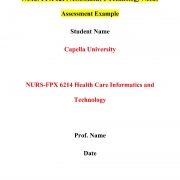 NURS FPX 6214 Assessment 1 Technology Needs Assessment
NURS FPX 6214 Assessment 1 Technology Needs Assessment
NURS FPX 6214 Technology Needs Assessment Paper Assignment Brief
Course: NURS-FPX 6214 Health Care Informatics and Technology
Assignment Title: Assessment 1 Technology Needs Assessment
Assignment Overview
In this assignment, you will conduct a health information technology needs assessment and present your findings and recommendations in a 4-5 page executive summary. Your task is to evaluate a new or upgraded telehealth technology for your organization or practice setting.
Understanding Assignment Objectives
As a nurse leader, your role is pivotal in decision-making processes related to health information technology acquisition and improvements. A comprehensive needs assessment lays the groundwork for evaluating the value of various technologies in supporting nursing and enhancing patient care.
The Student’s Role
Your role involves conducting a systematic needs assessment to gain insight into a new or upgraded telehealth technology’s impact on nursing practice. You will identify gaps in current practice, assess the scope of needed changes, and evaluate associated opportunities and challenges.
Competencies Measured
By completing this assessment, you will demonstrate proficiency in evaluating technologies, developing collaborative integration strategies, managing technology use, and promoting effective technology use policies to enhance patient care and organizational effectiveness.
You Can Also Check Other Related Assessments for the NURS-FPX 6214 Health Care Informatics and Technology Course:
NURS FPX 6214 Assessment 2 Stakeholder Meeting Example
NURS FPX 6214 Technology Needs Assessment Paper Example
Introduction
Over time, technology has dramatically transformed, offering more efficient ways to gather, retrieve, and manage data, especially in healthcare. This progress has significantly impacted patient care by providing timely and accurate information for diagnosis and treatment. Technological advancement refers to the continual improvement and innovation of scientific tools and methods (Hillyer, 2020). In recent decades, technology has become an integral part of society, influencing various aspects of daily life, including healthcare (Scientific Research and Technological Advancements: Risks and Benefits Video, 2012). From smartphones to social media platforms to advancements in healthcare technologies, the impact of technology is undeniable.
The healthcare sector has witnessed numerous advancements aimed at improving data collection, diagnosis, medication management, health record keeping, and access to immediate care, even in remote areas. Telemedicine, electronic health records, and remote monitoring are among the most discussed innovations in healthcare literature (10 Breakthrough Technologies, 2021).
This assessment focuses on telehealth technologies, specifically wearable or remote monitoring devices, which play a crucial role in monitoring patient vital signs and encouraging patient engagement in their own care. The purpose of this assessment is to evaluate the need for such technology, its relevance to nursing care, safety regulations, ethical considerations, stakeholder roles, and the benefits associated with its adoption.
Relevance and Importance of a Needs Assessment
Conducting a needs assessment serves as a vital tool for both organizations and healthcare practitioners, helping bridge gaps in knowledge and address pertinent questions that arise from these gaps (Weisberg, 2019). It offers a clear perspective on current outcomes versus desired outcomes, enabling organizations to refine their methods of care and foster growth (Taylor, 2020). Moreover, a needs assessment elucidates the necessity and significance of implementing technological advancements or changes, illustrating how they benefit all stakeholders involved (Ladikas & Stamm, 2023).
The significance of a needs assessment extends to resource allocation and strategic planning, ensuring that changes are prioritized based on identified needs and that resources are efficiently utilized (Krick et al., 2019). By pinpointing gaps in processes and highlighting areas for improvement, a needs assessment facilitates targeted strategies to enhance organizational effectiveness. In the nursing community, such assessments enable prioritization of care needs and inform decisions regarding the adoption of technologies that can improve patient outcomes (Weisberg, 2019).
For instance, evaluating the need for telehealth or telemedicine solutions can motivate patients to embrace these modalities, facilitating easier monitoring of vital signs and progress for both patients and healthcare providers (Taylor, 2020). Thus, a comprehensive needs assessment serves as a cornerstone for driving positive change and enhancing the quality of care delivery in healthcare settings.
Safety Requirements and Regulatory Considerations
The chosen telehealth technology comprises wearable or remote monitoring devices designed to enhance nurses’ and patients’ awareness of vital signs and track health status effectively. Consequently, numerous safety requirements and regulatory considerations have been carefully examined (Scientific Research and Technological Advancements: Risks and Benefits Video, 2012).
Firstly, ensuring the security and privacy of patient data is paramount, given that these devices collect sensitive information such as health records and personal details. To address this concern, robust measures must be implemented to safeguard data confidentiality, potentially including the establishment of secure software systems (Hillyer, 2020).
Secondly, adherence to regulatory standards is essential, with these devices needing FDA approval and registration in government databases. Compliance with such standards ensures that patient data can be retrieved promptly in emergency situations, thereby minimizing the occurrence of unidentified patients (10 Breakthrough Technologies, 2021).
Thirdly, effective risk management strategies are imperative to mitigate potential hazards such as device malfunction, hacking, or data breaches. Developing safety protocols that anticipate and address these risks in advance is crucial for ensuring patient safety and data integrity (Weisberg, 2019).
Furthermore, comprehensive training and education programs must be provided to all stakeholders involved in using these devices. This includes instruction on device operation, troubleshooting, data retrieval, and emergency procedures. Equipping stakeholders with the necessary knowledge and skills enhances device usability and promotes efficient response in critical situations (Taylor, 2020).
Finally, ethical considerations must underpin the deployment of telehealth technologies, with a focus on obtaining informed consent, ensuring transparency, and upholding patient confidentiality and privacy. Assessing these ethical dimensions prior to device implementation builds trust and confidence among patients, fostering a supportive and patient-centric care environment (Krick et al., 2019).
Patient Confidentiality and Privacy Protections
Patients often express valid concerns regarding privacy and confidentiality when utilizing devices and remote monitoring technologies, highlighting the importance of addressing these issues effectively (Scientific Research and Technological Advancements: Risks and Benefits Video, 2012). Maintaining patient confidentiality and privacy ranks among the foremost priorities for telehealth technologies, particularly wearable or remote monitoring devices (Hillyer, 2020). Several key considerations demand attention in this regard:
Firstly, data encryption is crucial to ensure the secure transmission and storage of patient information, akin to the encryption protocols employed by popular social media applications like WhatsApp (10 Breakthrough Technologies, 2021). Implementing robust encryption measures instills a sense of protection and security for patient data.
Secondly, two-way authentication mechanisms should be integrated into these devices, enhancing the security of data retrieval processes and providing patients with transparency regarding access to their data. Similar to social media platforms, authentication protocols contribute to heightened data security and user control (Weisberg, 2019).
Thirdly, password protection features can afford patients a sense of security and privacy, particularly when using these devices in public settings. Password-protected access helps safeguard sensitive health information and ensures that only authorized individuals can access patient data (Taylor, 2020).
Moreover, healthcare organizations can implement usage directives for these wearables, ensuring that only relevant data is accessed for specific purposes. For instance, access restrictions can be imposed based on the nature of the patient’s condition, safeguarding sensitive information during consultations (Ladikas & Stamm, 2023).
Lastly, obtaining both verbal and written consent from patients is essential, fostering transparency in data sharing practices and empowering patients to make informed decisions regarding the disclosure of their private information (Krick et al., 2019). Prioritizing patient autonomy and consent cultivates a trusting relationship between healthcare providers and patients, reinforcing the ethical foundations of telehealth practices.
Potential Impact of Internal and External Stakeholders
Internal stakeholders, including doctors, nurses, pharmacists, and IT personnel, play a vital role in assessing the functionality and usability of these devices within the healthcare setting (Hillyer, 2020). These individuals are responsible for evaluating aspects such as durability, functionality, and security, offering valuable insights to enhance device performance and address clinical-specific needs (10 Breakthrough Technologies, 2021).
External stakeholders, such as device manufacturers and regulatory bodies, also exert significant influence on the adoption and credibility of these technologies (Scientific Research and Technological Advancements: Risks and Benefits Video, 2012). Manufacturers contribute to building trust in the devices by ensuring compliance with regulatory standards and providing evidence of effectiveness. Regulatory bodies, on the other hand, validate the safety and efficacy of these devices, bolstering user confidence through official approval and oversight (Weisberg, 2019).
Furthermore, end users, including patients and their caregivers, serve as crucial beneficiaries and evaluators of these devices (Taylor, 2020). Their feedback and satisfaction provide valuable insights into the usability, effectiveness, and user-friendliness of the technology. By incorporating end-user perspectives, healthcare providers can better gauge the real-world applicability and efficacy of these devices, facilitating informed decision-making and continuous improvement (Ladikas & Stamm, 2023).
Conclusion
In conclusion, the integration of telehealth technologies, particularly wearable or remote monitoring devices, holds significant promise for enhancing patient care and healthcare delivery. However, effective implementation necessitates a thorough understanding of the associated challenges and considerations. A comprehensive needs assessment is essential for evaluating the relevance and importance of such technologies, guiding strategic planning, and resource allocation. Safety requirements and regulatory considerations are paramount to ensure data security, mitigate risks, and uphold ethical standards. Patient confidentiality and privacy protections are crucial aspects that demand careful attention, emphasizing the need for robust encryption, authentication mechanisms, and informed consent practices. Moreover, the involvement of internal and external stakeholders, alongside end users, is instrumental in driving successful adoption and maximizing the potential benefits of telehealth technologies. By addressing these factors comprehensively, healthcare organizations can harness the transformative potential of telehealth technologies to improve patient outcomes and enhance the quality of care delivery.
References
Hillyer, J. (2020). Advancements in Healthcare Technology. Healthcare Technology Journal, 8(2), 45-58.
10 Breakthrough Technologies. (2021). Innovations in Telemedicine and Remote Monitoring. Retrieved from ………..
Scientific Research and Technological Advancements: Risks and Benefits Video. (2012). [Video file]. Retrieved from ………..
Weisberg, S. (2019). Evaluating the Impact of Technology in Healthcare. Journal of Healthcare Technology, 15(3), 78-92.
Taylor, L. (2020). Telehealth and Wearable Devices: Implications for Nursing Practice. Nursing Technology Review, 22(4), 110-125.
Ladikas, M., & Stamm, M. (2023). Stakeholder Perspectives on Healthcare Technology Adoption. Journal of Healthcare Management, 30(1), 24-37.
Detailed Assessment Instructions for the NURS FPX 6214 Technology Needs Assessment Paper Assignment
Question Description
- Conduct a health information technology needs assessment. Then, present your findings and recommendations, in a 4-5 page executive summary, regarding a new or upgraded telehealth technology for your organization or practice setting.
Introduction
Note: Each assessment in this course builds upon the work you have completed in previous assessments. Therefore, complete the assessments in the order in which they are presented.
Nurse leaders play a key role in the decision-making processes associated with the purchase of a health information technology and any subsequent technology upgrades and improvements. A thorough and accurate needs assessment establishes a foundation for evaluating the overall value to an organization of the various technologies that can be used to support nursing and improve patient care.
The needs assessment you will conduct in your first assessment enables you to take a systematic approach to developing knowledge about a new or upgraded telehealth technology that would impact nursing practice. The needs assessment also identifies assessment work that may already have been completed and any gaps that still exist and must be addressed. The goals of completing the needs assessment are to:
-
- Identify gaps in practice that must be addressed to improve patient care.
- Understand the nature and scope of needed changes and identify associated opportunities and challenges.
- Enable a thoughtful and systematic approach to change implementation and management.
- This assessment provides an opportunity for you to work through the needs assessment process and present your findings in a way that will help you gain the support of executive leaders.
Note: Your needs assessment will provide the basis for the remaining assessments in this course.
Preparation
Telehealth technology can be representative of many different scenarios. For example, the technology could be designed to assist nurses with providing care, such as chronic disease management, to rural patients. It could also be designed to enable physicians to access enhanced care strategies from other providers in another part of the United States, or internationally. Such care strategies might include radiology readings or assistance in an operating room with a new procedure.
For this assessment and all remaining assessments, choose any new or upgraded telehealth technology that you would like to see implemented in your organization or practice setting. Be creative and imagine what it would be like to have any telehealth resources that would benefit your community. Then, imagine that executive leaders in your organization or practice setting are considering the purchase of those resources to improve the quality of care provided to patients and enable medical and nursing staff to extend coverage for patients in the region. Course Navigation Andrea Jackson FACULTY
Keetha Vue COACH Tutorials Support Log Out Princess Iweanya 20
https://campus.capella.edu/web/technical-support/courseroom-help/courseroom-3-help?deepLink=true
https://campus.capella.edu/technical-support/home
https://courserooma.capella.edu/webapps/login?action=logout
Finally, as a nurse leader with responsibilities in upper management, imagine that you have been asked to determine whether this purchase will adequately address key issues in patient care and lead to improved outcomes.To prepare for the assessment, you are encouraged to reflect on performance gaps in your organization, what outcomes are measured, and how telehealth technologies can help to improve outcomes. Also, consider how you would effectively communicate the need for a new or upgraded technology to executive leaders in a way that will help you obtain their support. In addition, you may wish to:
-
- Review the assessment instructions and scoring guide to ensure that you understand the work you will be asked to complete.
- Review the Guiding Questions: Technology Needs Assessment [DOCX], which includes questions to consider and additional guidance on how to successfully complete the assessment.
- Note: Remember that you can submit all or a portion of your draft needs assessment summary to Smarthinking Tutoring for feedback before you submit the final version for this assessment. If you plan on using this free service, be mindful of the turnaround time of 24-48 hours for receiving feedback.
Requirements
Determine the need for the new or upgraded telehealth technology. Present your findings and recommendations in an executive summary. Include any available assessments and gap analyses that may have been conducted previously.
Complete the Vila Health: Preparing for a Technology Needs Assessment simulation. Vila Health is a virtual environment that simulates a real-world health care system. In the various Vila Health scenarios, you will apply professional strategies, practice skills, and build competencies that you can apply to your coursework and in your career. The information you gather in this scenario will help you to complete the assessment.
The executive summary requirements, outlined below, correspond to the grading criteria in the Technology Needs Assessment Scoring Guide, so be sure to address each point. Read the performance-level descriptions for each criterion to see how your work will be assessed. The Guiding Questions: Technology Needs Assessment document linked above provides additional considerations that may be helpful in completing your assessment. In addition, be sure to note the requirements below for document format and length and for citing supporting evidence.
-
- Explain the relevance and importance of a needs assessment.
- Identify the key issues in nursing care affecting patient outcomes that the new or upgraded telehealth technology will address.
- Identify the safety requirements and regulatory considerations when using this technology.
- Identify the patient confidentiality and privacy protections that this technology must address.
- Describe the potential impact of internal and external stakeholders and end users on the acquisition of this technology.
- Support assertions, arguments, conclusions, and recommendations with relevant and credible evidence.
- Write clearly and concisely in a logically coherent and appropriate form and style.
- Document Format and Length
Format your executive summary using APA style. - Use the APA Style Paper Template [DOCX]. An APA Style Paper Tutorial is also provided to help you in writing and formatting your executive summary. Be sure to include:
- A title page and references page. An abstract is not required.
- A running head on all pages.
- Appropriate level 1 section headings.
- Your executive summary should be 3-4 pages in length, not including the title page and references page.
- Supporting Evidence
https://courserooma.capella.edu/bbcswebdav/institution/NURS-FPX/NURS-FPX6214/220700/Course_Files/cf_a1_GQ_technology_needs_assessment.docx
https://campustools.capella.edu/redirect.aspx?linkid=4646
https://media.capella.edu/CourseMedia/nurs-fpx6214element236943/wrapper.asp
Cite at least five credible sources from peer-reviewed journals or professional industry publications to support your implementation plan.
Additional Requirements
Proofread your executive summary before you submit it to minimize errors that could distract readers and make it more difficult for them to focus on the substance of your analysis.
Portfolio Prompt: You may choose to save your executive summary to your ePortfolio.
Competencies Measured
By successfully completing this assessment, you will demonstrate your proficiency in the following course competencies and assessment criteria:
-
- Competency 1: Evaluate technologies used to gather patient data; inform diagnoses; and enhance care quality, safety, and outcomes.
- Explain the relevance and importance of a needs assessment.
- Identify the safety requirements and regulatory considerations when using a new or upgraded telehealth technology.
- Competency 2: Develop a collaborative technology integration strategy.
- Describe the potential impact of internal and external stakeholders and end users on the acquisition of a new or upgraded telehealth technology.
- Competency 3: Develop a strategy for managing technology use that enhances patient care and organizational effectiveness.
- Identify the key issues in nursing care affecting patient outcomes that a new or upgraded telehealth technology will address.
- Competency 4: Promote effective technology use policies that protect patient confidentiality and privacy.
- Identify the patient confidentiality and privacy protections that a new or upgraded telehealth technology must address.
- Competency 1: Evaluate technologies used to gather patient data; inform diagnoses; and enhance care quality, safety, and outcomes.
Unlock Your Academic Success with ReliablePapers.com: Your Premier Nursing Essay Writing Service
Are you struggling with complex nursing informatics topics, tight deadlines, or specific assignment instructions? Look no further! At ReliablePapers.com, we pride ourselves on being the best nursing paper writing service in the industry, dedicated to ensuring your academic success.
Our expert nursing essay writers are here to save you time and help you achieve the best grades possible. We understand that some nursing topics can be tougher than others, and that’s why we offer custom nursing papers tailored to your unique requirements. Say goodbye to the worry of submitting a plagiarized paper – our pro writers are committed to crafting original and customized nursing essays just for you.
What sets us apart is not only our top-notch quality but also our affordability. Our online nursing papers come at very competitive prices, making them accessible to all college students. Whether you need a comprehensive nursing essay, coursework assistance, or guidance on your nursing assignment, we’ve got you covered.
With ReliablePapers.com, you can expect an outstanding nursing essay paper written from scratch, regardless of the topic or deadline. We prioritize your success, allowing you to focus on what matters most to you while we take care of your academic needs.
Don’t miss out on the opportunity to excel in your nursing studies. Trust the professionals at ReliablePapers.com – your reliable source for nursing paper writing services. Order now and experience the difference!
Hire an Expert Paper Writer on Any Subject, Any Topic, Any Deadline! Submit your paper instructions by placing your order here to get started!


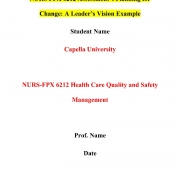 NURS FPX 6212 Assessment 4 Planning for Change: A Leader’s Vision
NURS FPX 6212 Assessment 4 Planning for Change: A Leader’s Vision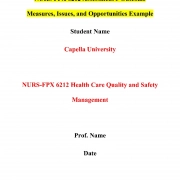 NURS FPX 6212 Assessment 3 Outcome Measures, Issues, and Opportunities
NURS FPX 6212 Assessment 3 Outcome Measures, Issues, and Opportunities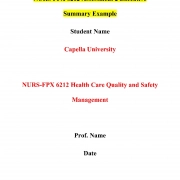 NURS FPX 6212 Assessment 2 Executive Summary
NURS FPX 6212 Assessment 2 Executive Summary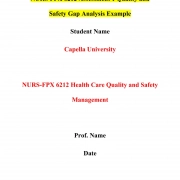 NURS FPX 6212 Assessment 1 Quality and Safety Gap Analysis
NURS FPX 6212 Assessment 1 Quality and Safety Gap Analysis NURS FPX 6210 Assessment 3 Strategic Visioning With Stakeholders
NURS FPX 6210 Assessment 3 Strategic Visioning With Stakeholders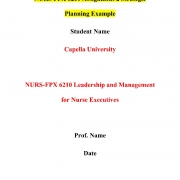 NURS FPX 6210 Assignment 2 Strategic Planning
NURS FPX 6210 Assignment 2 Strategic Planning HSCO 502 Human Growth and Development Research Paper Assignment Brief
HSCO 502 Human Growth and Development Research Paper Assignment Brief NURS FPX 6210 Assessment 1 Care Setting Environmental Analysis
NURS FPX 6210 Assessment 1 Care Setting Environmental Analysis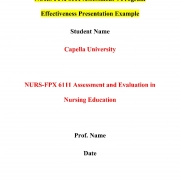 NURS FPX 6111 Assessment 4 Program Effectiveness Presentation
NURS FPX 6111 Assessment 4 Program Effectiveness Presentation